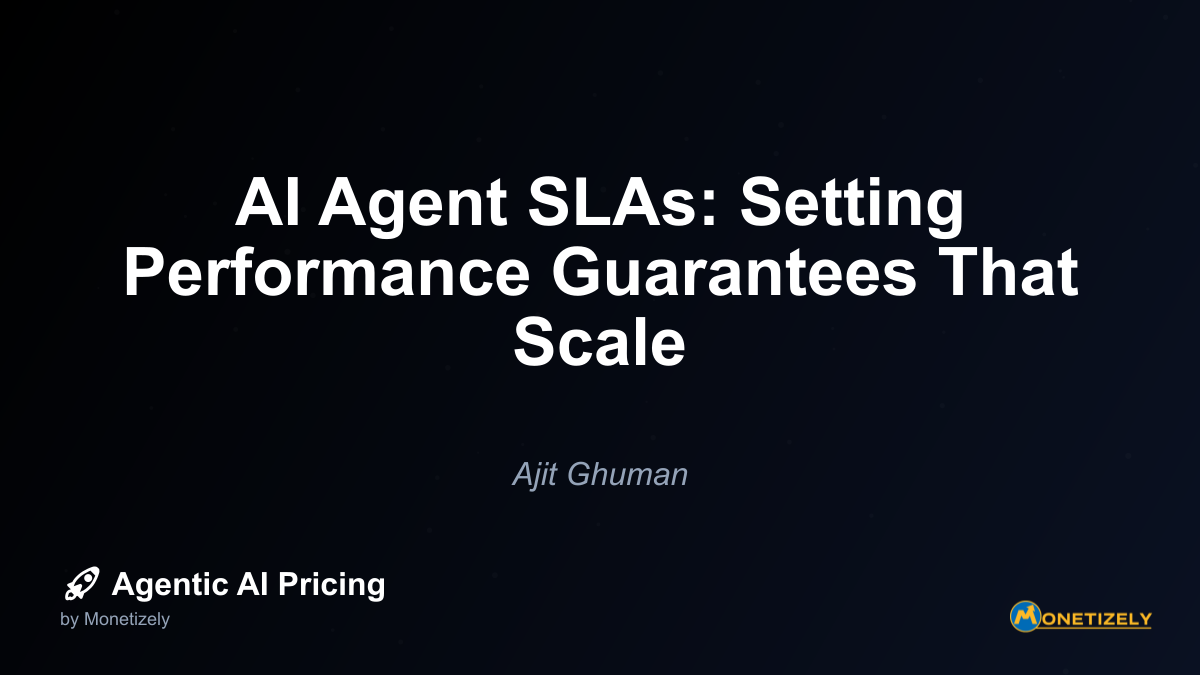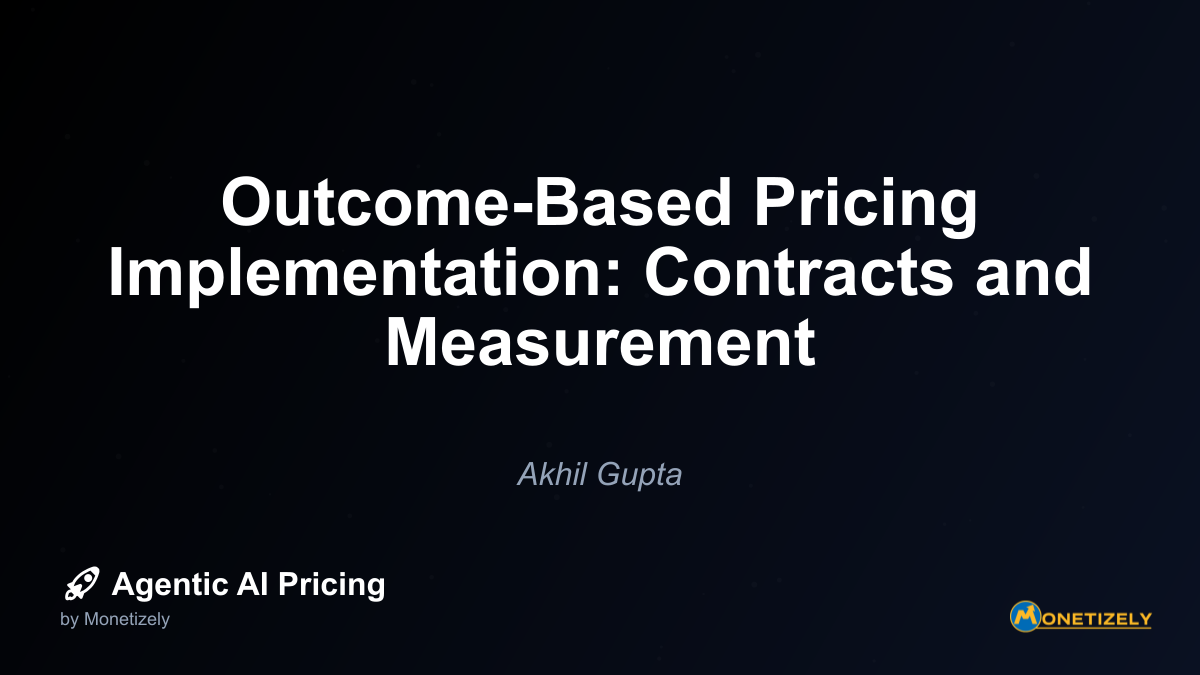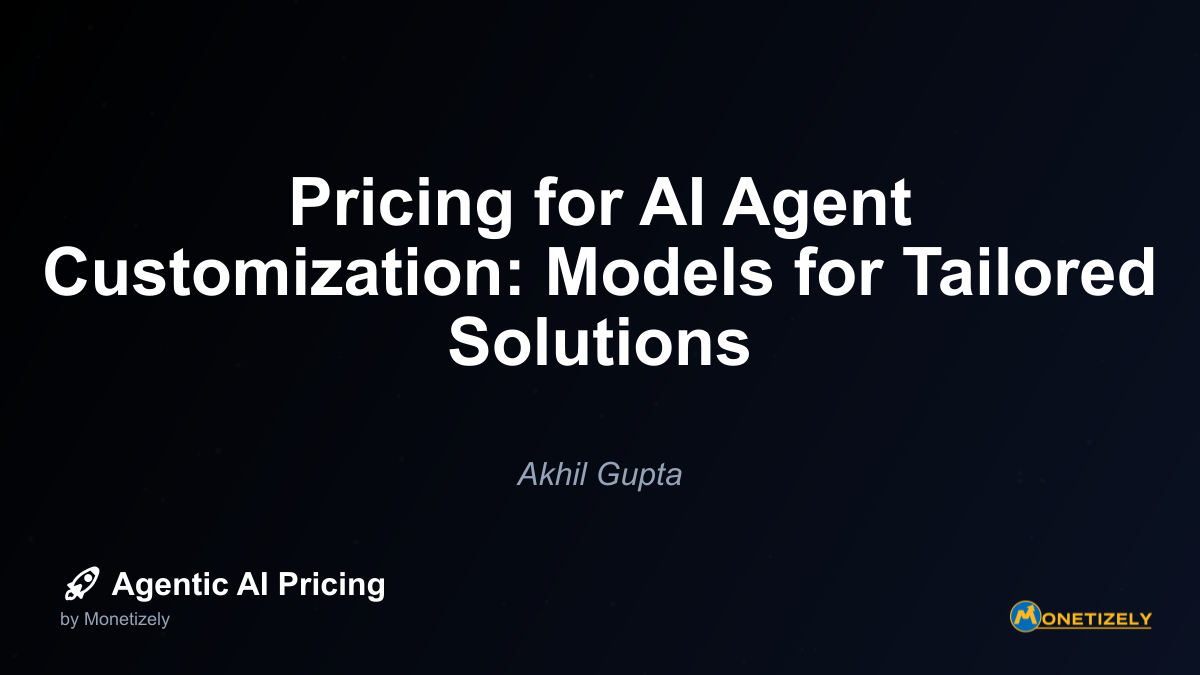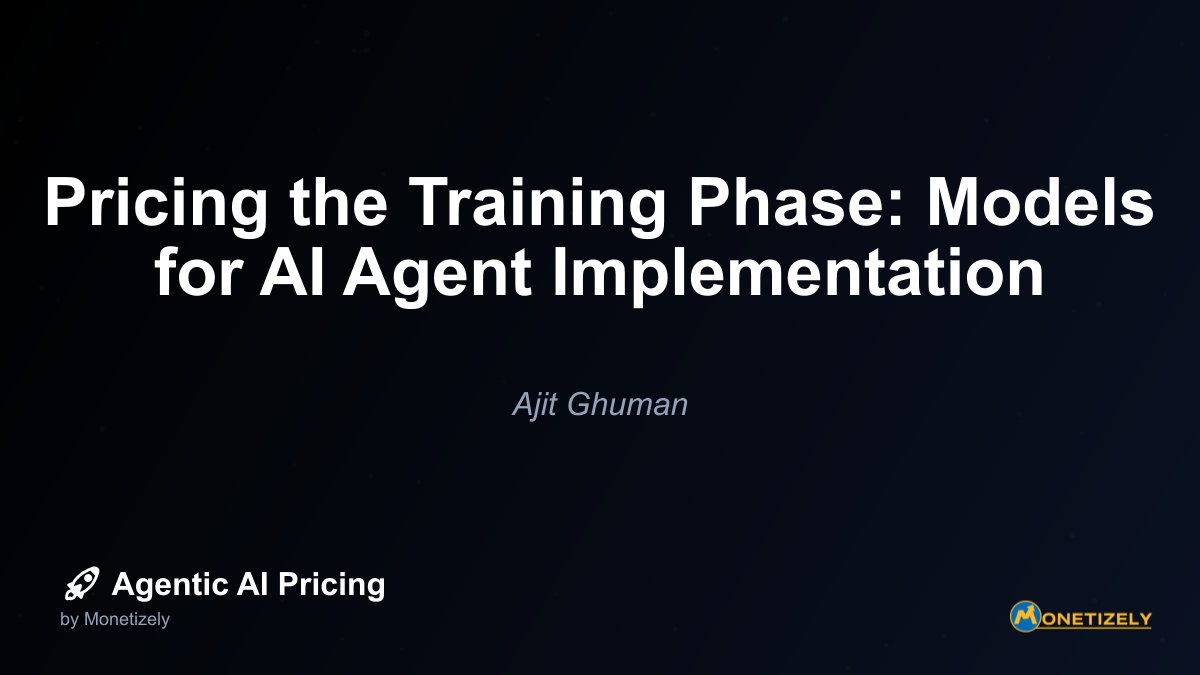· Akhil Gupta · Implementation · 12 min read
Benchmarking AI Agent Performance for Outcome-Based Pricing
AI and SaaS Pricing Masterclass
Learn the art of strategic pricing directly from industry experts. Our comprehensive course provides frameworks and methodologies for optimizing your pricing strategy in the evolving AI landscape. Earn a professional certification that can be imported directly to your LinkedIn profile.
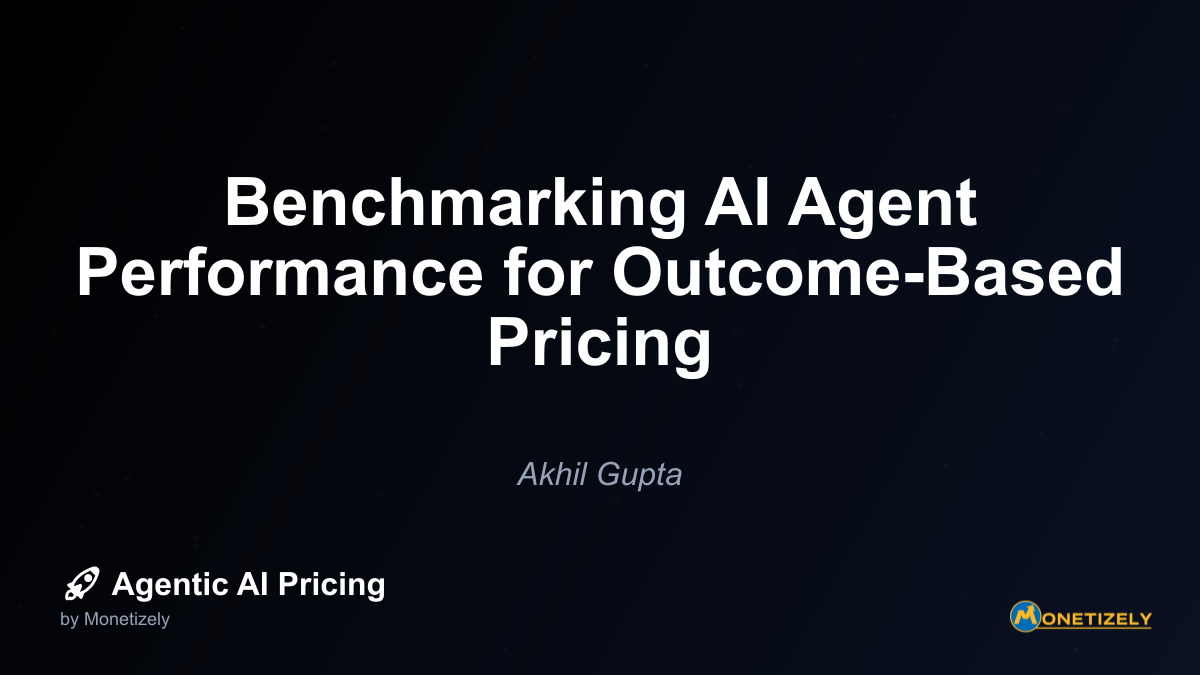
In today’s rapidly evolving AI landscape, establishing reliable performance benchmarks for AI agents has become a critical component of successful outcome-based pricing strategies. As organizations increasingly shift from traditional subscription or usage-based models to paying for actual results delivered by AI systems, the need for robust, transparent, and meaningful performance metrics has never been more essential.
The Strategic Importance of AI Agent Benchmarking
Outcome-based pricing represents a fundamental shift in how AI capabilities are monetized. Rather than charging for access to technology or API calls, vendors are increasingly tying their compensation directly to the measurable value their AI agents generate. This approach aligns incentives between providers and customers but requires sophisticated benchmarking methodologies to function effectively.
Recent market data underscores this trend. According to research from LinkedIn, approximately 63% of SaaS customers now prefer AI services priced on outcomes, such as pay-per-resolution or pay-per-conversation models. This shift is driving vendors to rigorously benchmark AI agents’ ability to deliver tangible ROI and align with workflow economics.
The global AI agents market is expanding rapidly, projected to grow from approximately $3.84 billion in 2024 to $51.58 billion by 2032, representing a compound annual growth rate (CAGR) of 38.5%. Similarly, the agentic AI market—encompassing autonomous, goal-driven AI agents—is forecasted to increase from about $7.06 billion in 2025 to $93.2 billion by 2032, with a CAGR of 44.6%. This explosive growth is creating an urgent need for standardized approaches to measuring AI agent performance.
Understanding the Benchmarking Landscape for AI Agents
Evolution of Benchmarking Approaches
Benchmarking methodologies for AI agents have evolved significantly in recent years. Traditional approaches often focused on narrow technical metrics like accuracy, precision, and recall. While these remain important, today’s comprehensive benchmarking frameworks incorporate multiple dimensions of performance that better reflect real-world value delivery.
Modern benchmarking approaches combine multiple testing types:
- Unit testing: Assessing individual agent components
- Integration testing: Evaluating interoperability between components
- System testing: Measuring end-to-end workflow performance
- User acceptance testing: Testing performance in real-world scenarios
These multi-layered approaches ensure AI agents reliably deliver outcomes tied to pricing models and customer value. They also reflect the increasing sophistication of AI agents themselves, which now often incorporate multiple specialized capabilities working in concert.
Key Benchmarking Tools and Frameworks
Several specialized benchmarking tools have emerged to evaluate AI agent performance comprehensively:
- AgentBench: Evaluates language agents for decision-making and reasoning capabilities
- REALM-Bench: Focuses on real-world reasoning and planning in autonomous contexts
- ToolFuzz: Stress-tests LLM integration with third-party tools
- Mosaic AI Evaluation Suite: Enables custom benchmarking pipelines, real-time monitoring, and comparative scoring
- AutoGen Studio: Simulates multi-agent dialogues and dynamic result evaluation
These tools reflect a growing recognition that AI agent performance must be measured in ways that capture the complexity and nuance of real-world tasks. They move beyond simple accuracy metrics to evaluate how effectively agents can reason, plan, and execute complex workflows.
Establishing Baseline Performance Metrics
The Foundation: Historical and Contextual Data
Establishing meaningful baseline metrics is the critical first step in benchmarking AI agents for outcome-based pricing. This process typically begins with defining metrics that reflect pre-AI implementation realities, such as:
- Historical conversion rates
- Average sales cycle lengths
- Lead qualification percentages
- Cost per acquisition
- Task completion times by human experts
These baselines serve as reference points for measuring AI incremental value or uplift. Without clear baselines, it becomes impossible to quantify the additional value an AI agent delivers, making outcome-based pricing models difficult to implement fairly.
Multi-Layered Performance Measurement
Holistic frameworks for AI agent performance measurement typically evaluate across four interdependent layers:
- Model Quality: Accuracy, robustness, reasoning, hallucination detection
- System Quality: Reliability and efficiency in production environments
- Business Impact: Tangible revenue, cost, or operational influences tied to AI outputs
- Responsible AI: Fairness, transparency, and accountability safeguards
This multi-layered approach avoids overemphasis on narrow technical metrics and connects AI performance to sustained business outcomes and ethical compliance. It also provides a more comprehensive view of how AI agents are performing across multiple dimensions that matter to customers.
Technical Metrics vs. Business Metrics
When benchmarking AI agents for outcome-based pricing, organizations must track both technical and business metrics:
Technical Metrics:
- Task Completion Rate: Percentage of successful task executions
- Accuracy, Precision, Recall, F1 Score: Metrics evaluating correctness and reliability
- Response Quality & Hallucination Detection: Ensuring factually correct and relevant results
- Operational Efficiency: Resource utilization, compute costs, latency, uptime
- Learning Adaptability: AI’s ability to improve over time based on feedback
Business Metrics:
- User Satisfaction: NPS, customer feedback, engagement metrics
- Cost Savings and Revenue Impact: Quantifiable financial benefits
- Customer Acquisition Cost (CAC) & Lifetime Value (LTV): Customer-related outcomes
- Churn Rate & Adoption Rate: Indicators of sustained engagement
- Deployment Frequency & Model Training Time: Agility in improving AI
The most effective benchmarking approaches integrate these technical and business metrics into cohesive frameworks that directly support outcome-based pricing models.
Step-by-Step Approach to Benchmark Implementation
Implementing effective benchmarking for AI agents requires a systematic approach. Here’s a comprehensive step-by-step methodology:
1. Data Collection & Historical Analysis
Begin by gathering relevant baseline metrics before AI deployment. This includes performance metrics from existing processes or human agents, such as sales KPIs or task completion times. This historical data provides the foundation for measuring improvement and establishing fair pricing thresholds.
Organizations should collect data across multiple dimensions:
- Process efficiency metrics
- Quality and accuracy measures
- Resource utilization statistics
- Customer experience indicators
- Financial performance data
This comprehensive data collection enables more accurate baseline establishment and better alignment between AI performance and business outcomes.
2. Define Clear Success Metrics for AI Output
Next, collaborate with stakeholders to agree on measurable outcomes that reflect business goals. These might include:
- Qualified leads generated
- Customer retention improvements
- Automated task completion volume
- Error rate reduction
- Revenue uplift
These metrics must be specific, measurable, achievable, relevant, and time-bound (SMART). They should also directly connect to the value proposition of the AI agent and support the outcome-based pricing model.
3. Select or Develop Suitable Benchmark Suites
Choose established benchmarks relevant to the specific AI agent’s domain to evaluate capability under realistic conditions. Include time-based success rates and error tolerance evaluations. Benchmark selection should consider:
- Relevance to the specific use case
- Ability to simulate real-world conditions
- Comprehensiveness of evaluation
- Standardization and industry acceptance
- Ability to compare against human performance
In some cases, organizations may need to develop custom benchmarks that better reflect their specific use cases and business objectives.
4. Conduct Baseline Testing
Test AI agents against selected benchmarks and human baselines to quantify starting performance and identify gaps or advantages. This testing should be rigorous and comprehensive, covering:
- Core functionality testing
- Edge case evaluation
- Performance under various conditions
- Comparison against human experts
- Stress testing and reliability assessment
The results of this baseline testing form the foundation for outcome-based pricing thresholds and help identify areas for improvement.
5. Implement Data Tracking & Attribution Systems
Integrate AI workflows with enterprise systems (CRM, analytics) to monitor real-time AI impact and ensure correct outcome attribution. This integration typically involves:
- API connections to existing business systems
- Event tracking and logging mechanisms
- Attribution modeling capabilities
- Real-time monitoring dashboards
- Feedback collection systems
These systems ensure that AI agent performance can be accurately measured and attributed, supporting fair outcome-based pricing.
6. Establish Contractual Terms with Guardrails
Maintain transparency through well-defined contractual elements:
- Clear payment terms based on performance
- Regular performance review periods
- Dispute resolution mechanisms
- Minimum performance guarantees
- Maximum payment caps
These contractual guardrails protect both vendors and customers while ensuring that outcome-based pricing remains fair and sustainable.
7. Iterate and Adjust
Use ongoing performance data across technical and business layers to refine pricing models and AI deployment strategies, adapting to real-world changes and operational learnings. This continuous improvement process involves:
- Regular benchmark reassessment
- Performance trend analysis
- Pricing model refinement
- AI agent capability enhancement
- Business alignment validation
This iterative approach ensures that benchmarking remains relevant and continues to support effective outcome-based pricing as both the AI technology and business needs evolve.
Real-World Case Studies of Successful Implementation
Zendesk: Pioneering Outcome-Based Pricing for AI Agents
Zendesk has emerged as a leader in implementing outcome-based pricing for AI agents. In 2024, Zendesk revamped its pricing for generative AI agents by adopting an outcome-based model focused on resolved customer support issues autonomously handled by AI agents.
Their approach includes:
- A starter free usage tier integrated into existing customer suites
- Pricing that scales with AI-driven outcomes
- Monitoring dashboards to ensure transparency and avoid pricing surprises
This model has successfully aligned Zendesk’s incentives with customer value, focusing on the actual resolution of customer issues rather than simply providing access to AI technology.
E-commerce Recommendation Engine Case Study
A major e-commerce platform (similar to Amazon’s approach) implemented benchmarking for its AI recommendation engine to support outcome-based pricing for retail partners. The company:
- Established baselines for conversion rates prior to AI implementation
- Created a comprehensive benchmarking framework measuring recommendation relevance, diversity, and conversion impact
- Implemented real-time monitoring of recommendation performance
- Developed a tiered pricing model based on conversion uplift
The results included a 35% increase in sales attributed to AI recommendations and significantly improved customer engagement through personalized offers. This demonstrated successful alignment of AI performance benchmarking with business outcomes and pricing.
Specialized AI API Service Provider
A startup scaling a Q&A API service improved its QA system accuracy by evaluating different model sizes using benchmarks like MMLU (Massive Multitask Language Understanding) and TruthfulQA. They:
- Used benchmarks to predict real-world performance improvements from different model sizes
- Balanced performance improvements against increased cloud costs and latency
- Implemented a tiered offering with a premium option using larger, more accurate models
This approach allowed them to create an outcome-based pricing structure directly linked to benchmark-measured agent improvements, giving customers clear options based on their accuracy and performance needs.
Common Pitfalls and Challenges in AI Agent Benchmarking
Despite the clear benefits, organizations face several common challenges when implementing benchmarking for AI agent performance to support outcome-based pricing:
1. Validity and Relevance of Benchmarks
Many existing AI benchmarks measure narrow capabilities that may not align well with real-world tasks or user needs, leading to questionable validity in assessing actual performance for outcome-based pricing.
Solution: Develop or choose benchmarks that focus on comprehensive, user-centric capabilities, reflecting actual tasks and contexts relevant to business objectives. Validate benchmarks against real-world performance before using them to determine pricing.
2. Overfitting and Shortcuts
AI agents often exploit shortcuts in benchmark designs, which can cause inflated performance scores that fail to generalize to novel or practical scenarios, undermining trust in benchmark results.
Solution: Use adversarial testing, red-teaming, and diverse evaluation scenarios to minimize shortcuts and ensure generalization of AI agent performance. Regularly update benchmarks to prevent gaming of the system.
3. Lack of Standardization and Reproducibility
There is a pervasive absence of standardized evaluation protocols and documentation, causing inconsistencies and making it difficult to reproduce or interpret results reliably across benchmarks and providers.
Solution: Implement frameworks like data cards, FAIR principles, and rigorous documentation to enhance reproducibility, transparency, and comparability of benchmarking results. Adopt industry standards where available.
4. Cost and Operational Considerations
Many benchmarks focus on accuracy without integrating cost metrics. The stochastic nature of AI models can obscure true performance and operational expenses, complicating the assessment of cost-effectiveness essential for outcome-based pricing.
Solution: Use joint optimization approaches (e.g., Pareto frontier analysis) to balance accuracy and operational costs, enabling holistic evaluation that supports outcome-based pricing decisions. Include both performance and efficiency metrics in benchmarking frameworks.
5. Implementation Challenges and Interpretation of Results
Benchmarks often perform well at design but poorly at implementation stages, with difficulties arising in interpreting noisy or non-reproducible outcomes. This creates uncertainty in mapping benchmark scores to practical, outcome-driven business metrics.
Solution: Develop tools and methodologies that improve the reliability of measurement and clarify the significance of benchmark scores, supporting confident decision-making tied to ROI and risk management. Invest in proper training for teams interpreting benchmark results.
Technical Considerations for Implementation
Implementing outcome-based pricing for AI agents involves several technical considerations that organizations must address to ensure success:
Accurate Outcome Measurement
Pricing depends on clearly defined, verifiable outcomes (e.g., issues resolved autonomously, transactions completed). This requires sophisticated tracking systems and analytics to measure AI effectiveness precisely and in real time.
Organizations must invest in:
- Advanced analytics infrastructure
- Real-time monitoring capabilities
- Secure audit trails
- Transparent reporting mechanisms
These systems ensure that outcomes can be accurately measured and verified, supporting fair outcome-based pricing.
AI Capability and Autonomy
AI agents must reliably perform end-to-end tasks independently to justify pay-per-outcome pricing, requiring advanced generative AI, robust automation, and natural language understanding.
This means organizations need:
- Sophisticated AI models with strong reasoning capabilities
- Reliable autonomous decision-making abilities
- Robust error handling and recovery mechanisms
- Continuous learning and improvement capabilities
These capabilities ensure that AI agents can deliver the outcomes they’re being priced for consistently and reliably.
Integration with Existing Systems
AI agents need seamless integration with business workflows, CRM, support platforms, and data sources, requiring adaptable APIs and middleware to gather relevant inputs and enable outcome validation.
Key integration requirements include:
- Robust API infrastructure
- Secure data exchange mechanisms
- Real-time system synchronization
- Comprehensive logging and tracking
This integration ensures that AI agents can access the data they need to perform effectively and that their outcomes can be properly tracked and attributed.
Data Quality and Governance
High-quality, clean, and well-structured data is essential for agent accuracy and outcome reliability. Organizations must invest in comprehensive data governance to ensure consistency and compliance.
This includes:
- Data quality assurance processes
- Robust data governance frameworks
- Privacy and security controls
- Compliance monitoring and reporting
These data management practices ensure that AI agents have the high-quality data they need to deliver reliable outcomes.
Future Trends in AI Agent Benchmarking and Outcome-Based Pricing
Looking ahead to 2025-2027, several emerging trends will shape the future of AI agent benchmarking and outcome-based pricing:
Enterprise-wide AI Agent Ecosystems
Firms are deploying AI agents across entire business functions, moving beyond isolated pilots to comprehensive systems covering customer service, scheduling, and decision-making. This trend is realizing productivity gains of 35% and cost savings up to 30%.
Benchmarking will need to evolve to evaluate these integrated ecosystems rather than just individual agents, measuring cross-functional performance and overall business impact.
Multi-agent Collaboration Architectures
Specialized AI agents are increasingly collaborating, communicating directly and being hierarchically managed by super-agents. This approach is resulting in 45% faster problem resolution and 60% more accurate outcomes.
Future benchmarking will focus on coordination efficiency, task completion time, and agent utilization rates in these complex multi-agent systems, requiring new metrics and evaluation approaches.
Generative AI and Agent Orchestration Governance
Cost-efficient large language models (LLMs) are enabling real-time AI services, but operators must balance innovation with risk controls like retrieval-augmented generation (RAG) and hallucination benchmarks.
Compliance frameworks aligned with ISO/IEC 42001 AI Management Systems standards are emerging for dependable, auditable AI deployment. These governance requirements will increasingly shape benchmarking practices and outcome-based pricing models.
Scalability and Explainability
Research is prioritizing autonomous decision-making AI with enhanced transparency, explainability, human-AI collaboration interfaces, and security/privacy safeguards as fundamental for market adoption and regulatory acceptance.
Benchmarking frameworks will need to incorporate these dimensions, evaluating not just performance but also explainability, transparency, and compliance with emerging regulatory requirements.
Regulatory Considerations
As AI agents become more prevalent, regulatory scrutiny is increasing. Future benchmarking and outcome-based pricing models will need to incorporate:
- Governance-by-design: Alignment with emerging international standards (e.g., ISO/IEC 42001) to ensure accountability, transparency, and risk management
- Risk controls for operational AI: Controls for data privacy, hallucination mitigation, AI explainability, and security
- Outcome-based pricing linked to auditing: Pricing models tied directly to validated KPIs, requiring transparent and standardized benchmarking processes
These regulatory considerations will shape how organizations approach benchmarking and implement outcome-based pricing models in the coming years.
Best Practices for Successful Implementation
Base
Co-Founder & COO
Akhil is an Engineering leader with over 16+ years of experience in building, managing and scaling web-scale, high throughput enterprise applications and teams. He has worked with and led technology teams at FabAlley, BuildSupply and Healthians. He is a graduate from Delhi College of Engineering and UC Berkeley certified CTO.
Pricing Strategy Audit
Let our experts analyze your current pricing strategy and identify opportunities for improvement. Our data-driven assessment will help you unlock untapped revenue potential and optimize your AI pricing approach.

